Pieter Pourbus
Pieter Jansz. Pourbus (c. 1523–1584) was a Flemish Renaissance painter, draftsman, engineer and cartographer who was active in Bruges during the 16th century. He is known primarily for his religious and portrait paintings.[1]

Life
Birth and origin
Pieter Pourbus was born in Gouda in 1523 or 1524. He moved to Bruges at the age of 20. Very little is known of his childhood and youth while living in Gouda; contemporary artists such as Karel Van Mander only make a brief mention of his origins in the city.
Early years in Gouda
His first biography was written by contemporary artist biographer Karel van Mander in his renowned "Painting Book" ("Schilder-boeck") of 1604[2].
"Even so, I would not like to conceal any of the most special. That is why I wish to present this view of Pieter Pourbus".
"Born in the Dutch town of Gouda, he based himself in Bruges from an early age"[2].
With these words, Karel van Mander, the author of the 1604 work "Het Schilder-Boeck, over t' leven der Vermaerde Doorluchtighe Schilders" ("The Book of Painters, about the life of Renowned Honourable Painters") describes his colleague from Bruges. Karel remembers him as "the painter of Bruges".
The two met in 1580, when Van Mander fled the ravages of the Eighty Years' War and stayed in Bruges for a time.
Pourbus must have overwhelmed him with information about all of the beautiful sights of Bruges at that time, as he was the source for most of the information Van Mander provides regarding the Bruges school of painting[3].
There are no portraits Pieter Pourbus, but he may have included a self portrait on the left altar wing of the "Tryptych of the Holy Sacrament fraternity" in the St Saviour's Cathedral, Bruges.
At the time, Pourbus was not considered a native in Bruges itself. When he registered as a master painter with the guild of Sculptors and Saddlers in 1543 as "Pieter Jansyns Poerbus", he is noted as a "stranger" ('vrymde') in the records. He was 19 or 20 years old at the time, based on the mentions of his age in a number of documents. From there, we can deduce that he must have been born in 1523 or 1524. At the occasion of the exhibition on Pieter Pourbus at the Gouda Museum in 2018, Paul Abels wrote in the catalogue of this exhibition about the role Gouda played in his life by putting what little is known about his ties to the city in the context of late-medieval religious and social life In Gouda[4].
Paul Abels has mentioned that the name 'Pourbus' features several times in Gouda at the start of the sixteenth century, but he adds that there is only one person in the Gouda city archives, a man named Jan Pieterssoen Pourbus, who could actually qualify as Pourbus' father. City accounts mention a payment made to him for "painting the board that stands in front of the window" in 1529. The mention is brief, but it corroborates Van Mander's claim about Pourbus' Gouda roots by another contemporary source.
In addition, this source shows that his father was also a painter, although it is not possible to know what his real artistic skills were. The mention most likely refers to painting the town's coat of arms on a shutter.[5]
From Gouda to Bruges
Pourbus' moved to Bruges, perhaps because Bruges is known to be a city that produces excellent painting, although that reputation was waning when Pourbus arrived.
Bruges is familiar territory for the Gouda residents. Pourbus would have heard many stories about the city of Bruges when growing up. The two cities are closely connected by the beer trade, which was the leading line of business in Gouda at the time. Before he went to Bruges, he may have studied his craft with Utrecht-based painters such as Jan van Scorel or the Leiden masters. Recent technical research suggests Leiden, more so than Utrecht[6].
Lucas van Leyden and Cornelis Engelbrechtsz passed away when Pourbus was still a child, but he may have come into contact with Engelbrechtsz's three sons, Cornelis, Lucas, and Pieter Cornelisz Kunst, who followed in their father's footsteps and became painters in their own right[6][7].
Pourbus in Bruges
Shortly after he registered with the Bruges Guild of Saint Luke, Pieter Pourbus married Anna, the youngest daughter of painter Lancelot Blondeel. His marriage to the daughter of an established artist lacking any male heirs became very important for his reputation and further career as a painter.[8]
In 1545 or 1546, Pourbus' son, Frans ('the Elder'), was born. He will later become a prominent artist in his own right.
Pourbus became a member of the Crossbowmen's Guild of St George and often visited the rhetorician meetings organised by the Chamber of the Holy Spirit. Blondeel, who was a well-respected person there, may have introduced him. Otherwise, very few concrete details of Pourbus' first few years in Bruges are known. It would appear that he initially operated as a student of Blondeel.[9]
Working in Blondeel's studio

It remains unclear in some cases whether paintings from this period were the result of collaboration between Pourbus and Blondeel, or whether they were painted by Pourbus alone; an example of this is the painting The Seven Joys of the Virgin, which today hangs in the Tournai Cathedral.
Pourbus' smaller work The Last Supper[10] indicates that his father-in-law also introduced him to the Rederijker or rhetorician circles of amateur poets and reciting artists[11].
A rare iconography is noticeable with the figure of a devil entering the room on the right of the painting.
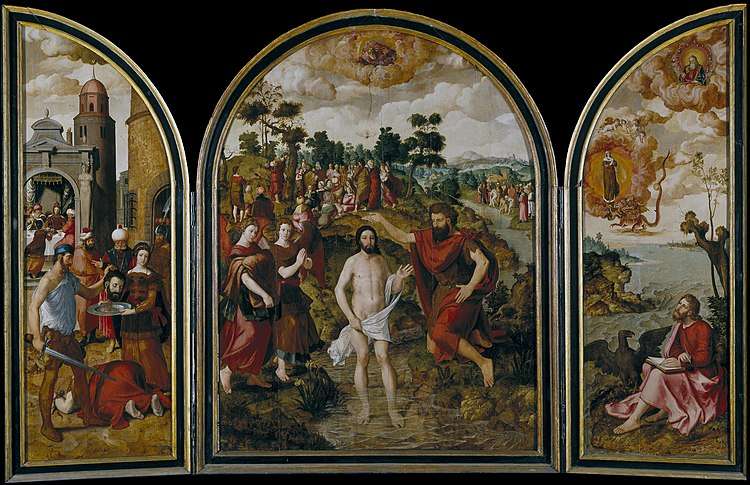
His triptych The Baptism of Christ, which dates back to 1549 and now hangs in the Museo del Prado in Madrid, is one of the most famous examples of his early work[12].
Another work that dates back to Pourbus' early years in Bruges is his only remaining non-religious history work, An Allegory of True Love, currently part of the Wallace Collection in London.
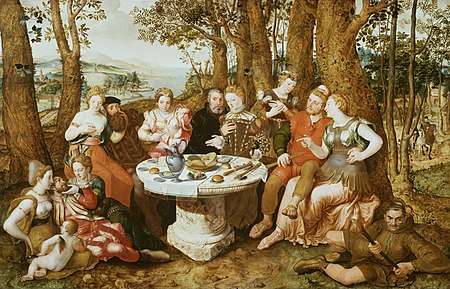
This work shows also how Pourbus style is truly innovative for his time.
Independent work
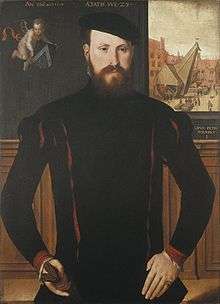

In 1549, Pourbus' name started to appear in a number of historical documents; he was named yearly, and sometimes even daily, in many official sources. During this period he received many notable commissions from the Brugse Vrije, such as the decorations for the Joyous Entry of Charles V and Philip II in 1549 ('Blijde intocht van Karel V en prins Filips in 1549'), a design for a new banquet hall, and the Last Judgment (Laatste Oordeel).
Another prominent commission was his works for the mausoleum of Margaret of Austria at the Annunciation Convent in Bruges, which the Annunciation currently displayed at Museum Gouda was part of.
Pourbus gradually became a popular portrait painter among the upper class, such as wine merchant Jan van Eyewerve and his wife Jacquemyne Buuck. In addition, Pourbus began to expressly date and sign his works in this period, indicative of the rise in his reputation and his growing artistic independence.
Pourbus also made many topographic maps during this period, which were intended to support surveyors' legal reports. He began using a new methodology based on triangulation that resulted in more accurate maps.
It is unknown how Pourbus obtained this knowledge, but his 1549 map of the canal between Damme and Sluis indicates that he was most likely already using the new technique at that time.
In 1552, Pourbus bought Huis Rome ('the Rome House') on the Heer Jan Admiraelstraat, and set up his own painting studio.[13]
Active Guild member
Around 1551, Pourbus became a prominent and active member of the council of the local Guild of St. Luke. He served two terms as dean of the guild and five terms as sworn elder. As an elder, he participated in quality checks on fellow guild members; for instance, he visited Simon Puseel in response to the latter's poor performance in gilding the dome of the Jerusalem Chapel in Bruges. As a dean, he acted to prevent paintings from Dordrecht being sold inside the city walls. He also defended the guild's interests several times in the leasing of land it owned in the province of Zeeland. Pourbus was also a very active member of the Bruges Guild of Sculptors and Saddlers.[14]
Pourbus as an established artist
Portraits
During this period Pourbus became notable for his portraits of nobility and wealthy merchants.
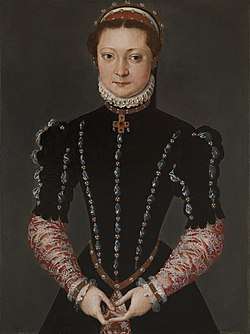
His Portrait of a Noble Young Lady is considered by many art historians, such as Paul Huvenne, to be one of the best examples of his portraiture; he writes that "[Pourbus] manages to lift the striking likeness that is expected of any portrait to an icon that radiates societal and spiritual values. In doing so, he endows the person depicted with a detached, but animated beauty that leaves no one unmoved"[15]. In an article published during the painting's exposition at the Gouda Museum, another historian describes this portrait as "the Mona Lisa of Pourbus"[16].
However, no inscription or family crest is to be seen on the painting, and it could not be found after IR or X-ray examination. It is therefore impossible to identify the lady depicted, but her rich dress and distinguished appearance suggests that the lady was of considerable standing. Her dress and its distinctive lace collar allowed Huvenne,[15] who discovered this painting, to date the portrait as having been painted before 1560. An IR examination conducted before the exhibition in Brugge in 2017 revealed that the portrait was done by Pourbus in 1554.
A recent hypothesis is that this portrait could be the portrait of Anna van Egmont, who was the first wife of William of Orange, also called William the Silent, (1533–1584), Prince of Orange, leader of the Dutch Revolt, founder of the House Orange-Nassau and the United Provinces as a state. Marc Couwenberg, who raised this possibility, published in 2018 a detailed article[17] which draws attention on many similarities between this portrait and the portrait of Anna van Egmont belonging to the Royal collection in The Hague:
Pourbus was also known for group portraits, such as the wing-panels with portraits of the Members of the Noble Confraternity of the Holy Blood and the Sacra Confrerie of St. Salvator's Cathedral. The position of the sitters in these portraits suggest that Pourbus was influenced by the work of Utrecht-based painter Jan van Scorel.
Religious paintings
Pourbus followed up on his Last Judgment and the Annunciation with the smaller Crucifixion in 1557.
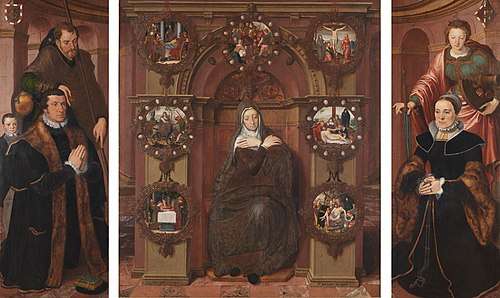
However, the Van Belle triptych is one of the most famous of his religious works and is often considered by art historians to be an important milestone in his career. An original design drawing of the painting contains handwritten comments, in which the artist agrees to portray the Madonna not with clenched hands but in a more resigned posture: with the arms pressed crosswise over one another. The theme of Our Lady of the Seven Sorrows was a popular subject of paintings in the Renaissance, and the unusual posture was perhaps an attempt to distinguish the painting from the many other depictions of the Virgin Mary at the time. The Van Belle triptych was partially influenced by the statue of the Madonna with Child by Michelangelo at the Church of Our Lady in Bruges.
Pourbus' 1558 Pietà at the Église Saint-Maurice in Annecy and his Adoration of the Golden Calf, painted around 1559, are also examples of his many religious works.
Pourbus and his painting style soon became the leading representative of the Italian High Renaissance as propagated in Antwerp by Frans Floris. One example of this style is the grotesques in which he depicted the portraits of Ghuyse-Van Male and his wife.
At this point, Pourbus' work featured more translucent brushwork and a clear composition style. These aspects are evident in the Van Belle triptych, in which he paraphrases the composition of Jan van Eyck's The Virgin and Child with Canon Van der Paele from 1434.
Pourbus began to gain a reputation in Bruges for his artwork and innovation; the Italian Ludovico Guicciardini names him as one of the most important painters of his time in his Descrittione di tutti i Paesi Bassi or Description of all the Low Countries in 1567.[18]
Influence and fame
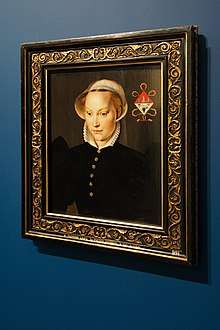
Blondeel passed away in 1561, and Pourbus soon surpassed him in notoriety. In the years that followed, he taught many apprentices, including his son and Antonius Claeissens.
One of his most well-known paintings from this period is his Portrait of a Woman with Unknown Coat of Arms.
In spite of the coat of arms, the subject of the painting has not yet been identified.
It has been suggested that she might be part of the De Grave family, who are originally from Flanders but settled in Andalusia.
The painting was often taken to be a portrait of Mary, Queen of Scots for much of the nineteenth century[19].
Scholars have noted the painting's smooth, enamel-like stylisation, and the woman's introverted and enigmatic quality.
This is reminiscent of Guicciardini's assertions that in Brugge, "" Women are as beautiful, charming, modest and temperate as in any town in these lands ""[20].
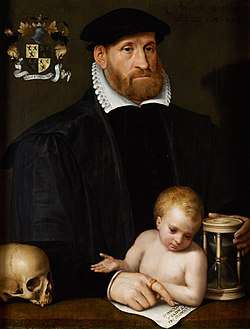

In 1567, Pourbus produced a portrait of Knight François van der Straten, a leading authority in the Liberty of Bruges and an academically trained lawyer. He drew inspiration from an allegorical print by Cornelis Theunisz from 1537 in which a child, an hourglass, and a skull reflect the theme of the transience of life in a similar matter to the portrait[21].
The motto on his coat of arms, "ABSIT GLORIA", which means "Reject glory", also reflects the notion of vanitas.
The text that he points out on the note beneath his hand reads "COGNITIO DEI ET NATVRAE RATIONALIS", which can be translated as "Knowledge of God and reasonable nature").
Both inscriptions are a reflection of the Renaissance humanist values of rationality, religion, and the worth of education, values that were then becoming dominant among the Northern European upper classes.
In the same year, he also painted the portrait of Pieter de Corte, the newly appointed bishop of the recently created bishopric of Bruges. De Corte was appointed by King Philip II of Spain; the prestige of such a commission indicates the high status that Pourbus had accrued by this time.
His Portrait of Juan Lopez Gallo and His Three Sons, dating back to 1568, reflects both his artistic style and the strength of his ties to the Spanish upper class. There, Pourbus dealt with his clients' differing customs by adjusting the size of his retables to suit the size of altar that was customary in Spain at the time.
Sometimes, he left the actual execution of paintings for his more distant clients to atelier staff, as shown in his Mount at Calvary in the Cathedral of San Pedro of Soria.
Map of the Liberty of Bruges
Pieter Pourbus was also a cartographer. And indeed, one of his most important commission of the 1560s is the monumental (3.22m x 1.51m) Map of the Liberty of Bruges[22].
He worked many days on this map, also helped by several persons (lawyers, surveyors, and magistrates). Accounts of that period allow to trace Pourbus' steps almost on a daily basis. They also provide information on how he adapted existing materials or created new ones, who worked on the map with him, who came along with him , and how he repeatedly presented his progress to the client[23].
He completed the map in 1571.
Later years and death
The 1570s

After the enormous effort of the Great Map, Pourbus once again was able to take on regular commissions.
During this time, his students began to leave his studio and become independent painters; Pourbus' son Frans left for Antwerp in 1569 to make his fortune as a painter there[24], and Antonius Claeissens became the official city painter of Bruges in 1570.
In addition, his style changed slightly during this period. His brushwork in these works and others of this period became less transparent and more enamel-like. This is seen in his portrait of Olivier Van Nieulant, which is now in the Royal Museum of Fine Arts Antwerp. This shift is also apparent in his history paintings, such as the Altarpiece of St. Hubert, painted around 1572. His change in style has been noted by scholars to lend a cooler appearance and a more classicist quality to his work, but also makes his subjects more rigid in appearance[25].
Even though he never travelled to Italy, Pourbus was greatly influenced by the artistic tradition of the Italian Renaissance, which the Altarpiece is a prime example of. Mander, one of his contemporaries, praised it as "a beautiful temple, with the perspective very well done". Usually, Pourbus drew his inspiration from artists of the Renaissance, such as Dürer, Raphael, and Titian. For example, he drew strongly on Titian for the middle panel of the Damhouder Triptych at the Church of Our Lady in Bruges.
As a well-established painter, Pourbus was occasionally seen as too expensive during this period. For example, in autumn of 1571, he created a design for an altarpiece for the Church of Our Lady in Damme, but a different, cheaper painter, Jacob van den Coornhuuse, was commissioned to do the work instead.
Pourbus' studio continued to operate throughout the 1570s.
Among others, he worked in close collaboration with Antonius Claeissens, who was influenced by Pourbus' style more than anyone else in Bruges in the early years of his career.
The spectacular piece Lamentation, one of the highlights of the exhibition at Museum Gouda in 2018, was the result of an intensive collaboration between the two.
The Eighty Years' War and aftermath
In 1578, a Protestant military force took over Bruges. There was little resistance to the invasion, and the city became a Calvinist republic.
Once the threat of war increased after the Pacification of Ghent failed, the city's magistrate repeatedly asked Pourbus for his advice on building the city's defenses. His knowledge of water management, for instance, could have been of use in flooding certain areas as a defensive manoeuvre.
Even after the change in power that follows the city's capture in 1578, Pourbus continued to serve the now Protestant city authorities and enjoyed the confidence of the new government. For example, he was appointed head of his district in Sint-Nicolaas-Zestendeel in December 1580.
This may indicate that he converted to Calvinism, like his son. His switch from Catholicism to Calvinism would mean that Pourbus became more intimately entwined with the Protestant upper class; he had already painted the portraits of various prominent Protestants in previous years, such as the wartime mayor Jan Wyts and Calvinist leaders such as Pieter Dominicle[26].
His epitaph for the Catholic Zeghere van Male, a rich merchant also known for a famous song book, probably dates back to 1578, before the invasion of Protestants from Ghent.
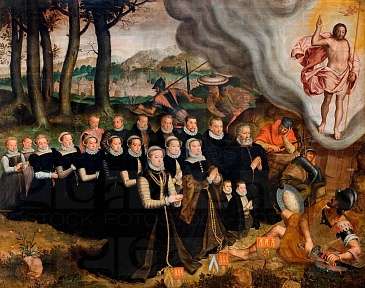
During this period, Pourbus was mainly active as a water management expert and engineer; his artistic output decreased as a result.
In 1580, he painted a plan of the Abbey of the Dunes that was intended to serve as a guide for the reconstruction of the monastic complex after the war. This indicates that he had enough credibility within the suppressed Catholic community left to be granted this commission.
In contrast, he also created the designs for the deconsecrated Church of St. Christopher in autumn of that same year to be turned into a market hall, because it was no longer permitted to be used for worship[27].
Pieter Pourbus died in January of 1584. He may have been one of the many victims of the Plague that struck Bruges at the time. His widow, Anna Blondeel, was allocated a pension by both the city's magistrate and the Liberty of Bruges. His portrait was hung in the guildhall as a memento to him.
Legacy
Pourbus was the leading figure of his generation in Bruges, often pioneering techniques. Stylistically speaking, he is part of the generation of Frans Floris.
This generation of painters realized the breakthrough of the Italian Renaissance in the Low Countries. For example, his Joyous Entry of Charles V and Prince Philip II, which dates from 1549, is a prime example of Renaissance architecture in Northern Europe.
In addition, Pourbus developed a recognizable hand that was influenced by classicism and its characteristic use of restraint and clear lines.
Pourbus' works are often considered to be the last examples of the old Bruges school of painting.
He tutored both his son and grandson, Frans the Elder and Frans the Younger, who then became respected artists in their own right and contributed greatly to the beginning era of the Golden Age.
Pourbus managed to make a name for himself during his lifetime as one of the most important painters of his generation, both in Bruges and elsewhere; for example, Italian contemporaries such as historian Ludovico Guicciardini and artist biographer Giorgio Vasari make favourable mentions of him[28].
Ludovico Guicciardini names him as one of the most important painters of his time in his "Decrittione di tutti i Paesi Bassi" or "Description of all the Low Countries" in 1567[29].
Works
Pieter Pourbus works can be seen at the Groeningemuseum of Bruges, the Gouda Museum, the Sint Janskerk, and the Church of Our Lady, Bruges.
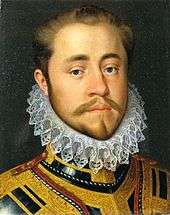 Portrait of a gentleman in armour, c. 1570-80, 35cm x 27.2cm, Musée de Picardie, France
Portrait of a gentleman in armour, c. 1570-80, 35cm x 27.2cm, Musée de Picardie, France Portrait of Christian van der Goes, 1574, 91cm x 67.5cm, top right inscript. : "A: Dm 1575 - Aetatis 44"
Portrait of Christian van der Goes, 1574, 91cm x 67.5cm, top right inscript. : "A: Dm 1575 - Aetatis 44" Bearded, red-headed man, seated 1555, 84 x 65 cm, Santander Bank Foundation, Madrid, Spain
Bearded, red-headed man, seated 1555, 84 x 65 cm, Santander Bank Foundation, Madrid, Spain The Baptism of Saint Hubertus, (before 1572), Gouda Museum, The Netherlands
The Baptism of Saint Hubertus, (before 1572), Gouda Museum, The Netherlands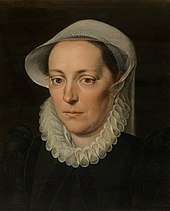 Portrait of a Woman, c. 1535-84, 34cm x 27.5cm, Inscriptions top left: "A.DNI.1548; middle above: OBIIT A 60; top right: AETATIS MEAE 56", Royal Museum of Fine Arts Antwerp, Belgium
Portrait of a Woman, c. 1535-84, 34cm x 27.5cm, Inscriptions top left: "A.DNI.1548; middle above: OBIIT A 60; top right: AETATIS MEAE 56", Royal Museum of Fine Arts Antwerp, Belgium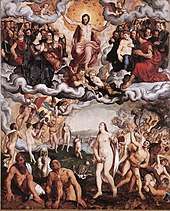 Last Judgement, 1551, 228.5 cm x 181cm, Groeningemuseum, Brugge, Belgium
Last Judgement, 1551, 228.5 cm x 181cm, Groeningemuseum, Brugge, Belgium
References
- Pieter Pourbus at the Netherlands Institute for Art History (in Dutch)
- Van Mander 1604, fol. 257r; original text in Dutch:'…Evenwel soud' ick niet geern eenige der besonderste verzwijgen. Daerom ick hier wil voor ooghen stellen Pieter Pourbus.
- Article written by Paul Huvenne, §.1 page 9, in Marc De Beyer & Josephina De Fauw, "Pieter Pourbus, Master painter of Gouda", 2018. Catalogue of the exhibition Feb.17 - June 17 2108 at Museum Gouda. 86 pages
- Article written by Paul H.A.M. Abels, §.1, page 31, in Marc De Beyer & Josephina De Fauw, "Pieter Pourbus, Master painter of Gouda", 2018. Catalogue of the exhibition Feb.17 - June 17 2108 at Museum Gouda. 86 pages
- Paul H.A.M. Abels, §. page 31, in Marc De Beyer & Josephina De Fauw, Pieter Pourbus, Master painter of Gouda, 2018. Catalogue of the exhibition Feb.17 - June 17 2108 at Museum Gouda. 86 pages
- Article written by Paul H.A.M. Abels, page 34, §2, in Marc De Beyer & Josephina De Fauw, "Pieter Pourbus, Master painter of Gouda", 2018. Catalogue of the exhibition Feb.17 - June 17 2108 at Museum Gouda. 86 pages
- Article written by Anne van Oosterwijk, page 66 § entitled "Pourbus' training", in Marc De Beyer & Josephina De Fauw, "Pieter Pourbus, Master painter of Gouda", 2018. Catalogue of the exhibition Feb.17 - June 17 2108 at Museum Gouda. 86 pages
- from the article written by Paul H.A.M. Abels, §. page 34, in: Marc De Beyer & Josephina De Fauw, "Pieter Pourbus, Master painter of Gouda", 2018. Catalogue of the exhibition Feb.17 - June 17 2108 at Museum Gouda. 86 pages
- Paul Huvenne, in Catalogue of the exhibition Feb.17 - June 17 2108 at Museum Gouda: Marc De Beyer & Josephina De Fauw, "Pieter Pourbus, Master painter of Gouda", 2018. 86 pages. §.1 page 11
- Pourbus made later five other depictions of the Last Supper (all of imposing size) in addition to the present painting, including the 1559 Triptych of the Brotherhood of the Sacrament (Saint James Church, Bruges) and that of 1562 in the Onze Lieve Vrouwekerk, Bruges. The former still retains its original double-sided wings, the left one showing Melchisedech's Offering and the right one, Elijah Fed by the Angel,
- Article written by Paul Huvenne, §.1 page 11, in Marc De Beyer & Josephina De Fauw, "Pieter Pourbus, Master painter of Gouda", 2018. Catalogue of the exhibition Feb.17 - June 17 2108 at Museum Gouda. 86 pages
- Article written by Paul Huvenne, page 12, in Marc De Beyer & Josephina De Fauw, "Pieter Pourbus, Master painter of Gouda", 2018. Catalogue of the exhibition Feb.17 - June 17 2108 at Museum Gouda. 86 pages
- Paul Huvenne, in Catalogue of the exhibition Feb.17 - June 17 2108 at Museum Gouda: Marc De Beyer & Josephina De Fauw, Pieter Pourbus, Master painter of Gouda, 2018. 86 pages. §.2 page 13
- Paul Huvenne, in Catalogue of the exhibition Feb.17 - June 17 2108 at Museum Gouda: Marc De Beyer & Josephina De Fauw, Pieter Pourbus, Master painter of Gouda, 2018. 86 pages. §.2 page 16
- "KMSKA Director Paul Huvenne to Retire on 1 August -". CODART. 11 June 2014.
- "De Mona Lisa van Pieter Pourbus meester-schilder uit Gouda | Marc Couwenbergh / cti". creative texts and images / cti - journalistieke producties over kunst, cultuur en historie (in Dutch). 25 February 2018. Retrieved 17 May 2020.
- https://marccouwenbergh.nl/anna-van-bueren-versus-de-mona-lisa-van-pieter-pourbus-meester-schilder-uit-gouda/
- Paul Huvenne, in Catalogue of the exhibition Feb.17 - June 17 2108 at Museum Gouda: Marc De Beyer & Josephina De Fauw, "Pieter Pourbus, Master painter of Gouda", 2018. 86 pages. page 16 to 20
- Paul Huvenne, in Catalogue of the exhibition Feb.17 - June 17 2108 at Museum Gouda: Marc De Beyer & Josephina De Fauw, "Pieter Pourbus, Master painter of Gouda", 2018. 86 pages. page 20
- Guicciardini, 1567, p. 302b
- Paul Huvenne, in Catalogue of the exhibition Feb.17 - June 17 2108 at Museum Gouda: Marc De Beyer & Josephina De Fauw, "Pieter Pourbus, Master painter of Gouda", 2018. 86 pages. page 21
- http://vlaamseprimitieven.vlaamsekunstcollectie.be/en/collection/map-of-bruges
- Paul Huvenne, in Catalogue of the exhibition Feb.17 - June 17 2108 at Museum Gouda: Marc De Beyer & Josephina De Fauw, "Pieter Pourbus, Master painter of Gouda", 2018. 86 pages. page 23
- "By 1564, he is recorded as working in the studio of Frans Floris in Antwerp", in Catalogue note, Sotheby's New York. Jan. 29th, 2015. https://www.sothebys.com/en/auctions/ecatalogue/2015/master-paintings-part-i-n09302/lot.34.html
- Paul Huvenne, in Catalogue of the exhibition Feb.17 - June 17 2108 at Museum Gouda: Marc De Beyer & Josephina De Fauw, "Pieter Pourbus, Master painter of Gouda", 2018. 86 pages. page 23
- Paul Huvenne, in Catalogue of the exhibition Feb.17 - June 17 2108 at Museum Gouda: Marc De Beyer & Josephina De Fauw, "Pieter Pourbus, Master painter of Gouda", 2018. 86 pages. page 25
- Paul Huvenne, in Catalogue of the exhibition Feb.17 - June 17 2108 at Museum Gouda: Marc De Beyer & Josephina De Fauw, "Pieter Pourbus, Master painter of Gouda", 2018. 86 pages. page 26
- Guicciardini, 1612, fol. 299
- Guicciardini, 1567, pp.79a-81a
Publications
- Paul Huvenne, Pierre Pourbus, peintre brugeois, 1524-1584, cat. exp., Musée Memling (Hôpital Saint-Jean), 29 juin-30 septembre 1984, Bruges, Crédit Communal, 1984.
- Paul Philippot, La Peinture dans les anciens Pays-Bas xve – xvie siècles, Paris, Flammarion, 1994, 303 p., (ISBN 978-2-08010-937-8), p. 230-231.
- Maryan W. Ainsworth, Win Blockmans, Till-Holger Borchert (et al.), Bruges et la Renaissance. De Memling à Pourbus, cat. expo., Bruges, 15 août-6 décembre 1998 Gand, Ludion ; Paris, Flammarion ; Bruges, Stichting Kunstboek, 1998, 319 p., (ISBN 90-5544-232-1).
- Irene Smets, Le Musée Groeninge à Bruges : un choix des plus belles œuvres, Ludion, 2000, 127 p. (ISBN 978-9-05544-257-7).
- (nl) Anne Van Oosterwijk, Maarten Bassens, Till-Holger Borchert, Heidi Deneweth, Brecht Dewilde (et al.), Vergeten Meesters, Pieter Pourbus en de Brugse schilderkunst van 1525 tot 1625, éd. : SNOECK GENT. Catalogue of the exposition at the Groeningemuseum, Bruges Oct.13, 2017 - Jan.21, 2018. 336 pages.
- (en) Anne Van Oosterwijk (et al.), The forgotten masters. Pieter Pourbus and Bruges painting from 1525 to 1625, éd. : SNOECK GENT. Catalogue de l'exposition au musée Groeninge de Bruges Oct.13 2017 - Jan.21 2018. 336 pages.
- (en) (nl) Marc De Beyer et Josephina De Fauw, Pieter Pourbus, Master painter of Gouda, 2018. Catalogue of the exhibition Feb. 17 - June 17 2108 in Museum Gouda. 86 pages.